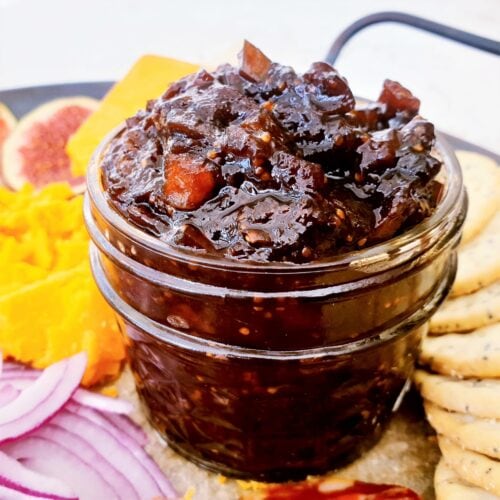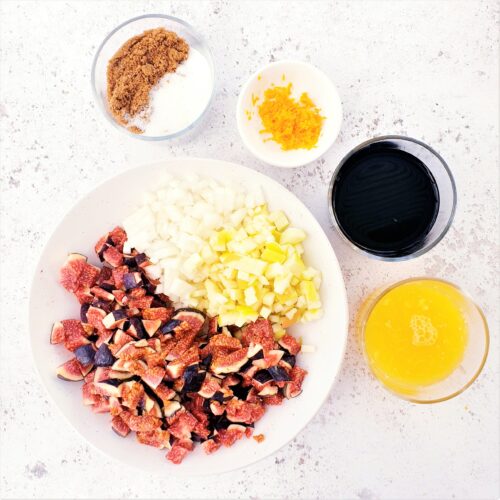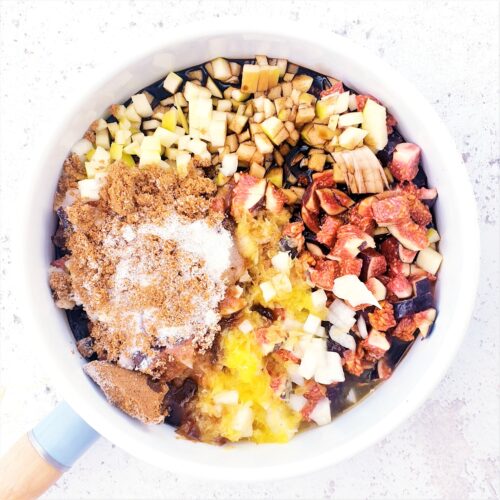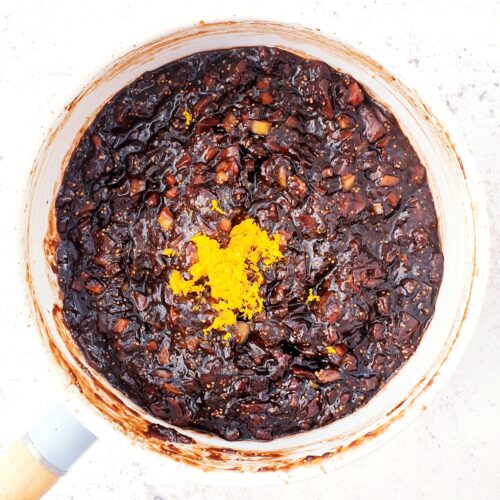Fresh Fig Chutney is dark, sweet, savoury and fruity in all the right ways. With a hint of orange but not spiced, this recipe is a one pan wonder perfect for first time chutney makers and more experienced preservers alike!

This post may contain affiliate links. Please refer to my Disclosures Page for more details.
There are a couple of varieties of chutney that I regularly buy and actually eat. I make the distinction because I have a bunch in the cupboard which sounded great in the shop but when push comes to shove, are never the ones I reach for.
The first is fig chutney. The problem is that I often struggle to find a fig chutney that isn’t laced with cinnamon (which I hate). So I decided to make the most of my fig tree and try making my own.
I am no militant preserver. I make my own Seedless Strawberry Jam and have a bit of a fruit curd habit – plum curd and fig curd are my current obsessions. Whilst I can’t see myself ever going bonkers making chutney like some folk, I’ll be making this fig chutney every year.
The joy of spending a tiny bit of time making your own preserves is that you can tailor the flavours to just how you like it. In this case I’ve added orange juice and zest rather than going in with any of the classic sweet spices like cinnamon, ginger, nutmeg or allspice.
I find that the orange adds an extra dimension whilst allowing the fig flavour to shine through. I’ve gone easy on the dark brown sugar for the same reason. And unlike fig and ginger chutneys which are quite common, I find the orange doesn’t jar with the foods I like to eat it with like cheese.
For the record, my second favourite chutney caramelised red onion. Also delish and easy to whip up at any time of year.

- How to Serve Fig & Orange Chutney
- Make Fresh Fig Chutney into a Feast
- Ingredients for Balsamic Fig Chutney
- Equipment Notes for Fresh Fig & Orange Chutney
- Get Ahead
- How to Sterilise Jars and Preserve/Can Chutney
- Leftover Chutney
- Fresh Fig Chutney Tips
- More Easy Chutney Recipes
- Keep Up to Date
- Full Step-By-Step Recipe
How to Serve Fig & Orange Chutney
I have done some extensive testing involving eating chutney every day for two weeks to find out when this recipe matures to be at its very best. And it’s around day three. So the good news is that you don’t have to wait months to tuck in.
Saying this, the difference is actually very subtle. If you want to dig in the same or next day, this fig chutney is actually still great.
I eat 80% of my chutney with cheese. That might be as part of a cheese and meat board like in the photos on this page, with a more simple snack of bread or crackers with one cheese. A simple supper of cheese on toast or a ham and cheese toastie will also often get a bonus layer of chutney.
The other 20% of my chutney involves baking it into pastries, usually sausage rolls. A cheeky layer spread under the sausage meat when making the large or mini versions is a treat. As this chutney recipe is vegan, it works with vegan sausage rolls too.
Whilst not a serving suggestion as such, it would be remiss of me not to mention that homemade chutney makes an incredible homemade gift!

Make Fresh Fig Chutney into a Feast
I truly believe that you can make any dish into a proper feast! Whether thats a feast for one after work on a Tuesday, a casual feast for four on a Friday evening or a feast for 12 for a special occasion!
Creating a simple cheeseboard is easy. Look for at least two or three different styles of cheese. Try a brie, a fiery cheddar and something a bit different like a smoked cheese, a fruity one or a blue if that’s your thing.
Add some bread or crackers and either some fresh fruit or salad bits. I always like to serve my 5 Minute Pickled Red Onions for a little crunch and colour.
For meat eaters, I add slices of pork pie to make it into more of a ploughman’s style lunch and/or some cured meats like prosciutto, chorizo, salami or ham. And of course, don’t forget the Salty Butter and chutney!
Don’t forget to head over to my Feast Collection pages to find all of my tips and tricks to help you host a fun and stress-free feast. Plus remember to check out my recipe index to create your own awesome Feast!

Ingredients for Balsamic Fig Chutney
Figs
I’ve specified ripe figs in the recipe because the flavour is less pronounced in under-ripe figs. You can use them but ripe and yielding is preferable.
I have specified a weight of figs rather than a quantity. Figs are not all created equal. The ones from my tree can be wildly different sizes. And the kind that I buy pre-packaged from the supermarket tend to be quite small turkish figs. But when sold loose in season they’re much bigger and beautiful looking.
I’m not lucky enough to have a great Turkish deli near my house here but when I was in London I would always head to the deli for fresh figs – if you have this option, I would highly recommend it.
Using Dried Figs
I wouldn’t recommend using dried figs instead of fresh in this recipe.
It is perfectly possible to make a dried fig chutney but the amount of figs/sugar/liquid will change quite a lot. If you’d like me to test a dried fig version, let me know in the comments section and I’ll put it on my list.
Apple
I’ve made the chutney with both regular eating apples and cooking apples like braeburn.
The apple is really there to provide a little bulk and I found the difference in sweetness minimal between the two types. So use whatever you have to hand and don’t stress about the variety.

Onion
I have again not specified the type of onion – red, white or yellow will all work great. What I wouldn’t use are shallots or spring onions/scallions etc. The flavours aren’t robust enough to provide the savoury notes that the onion is there for.
Orange
When testing the recipe I found that adding a little orange zest to the chutney right at the end gives it a freshness and zing of flavour. Adding the zest with the rest of the ingredients just wasn’t the same.
As I was using a fresh orange, it made sense to me to use the whole orange and add the juice too. The important thing to remember is to remove the zest then juice. Getting the zest off a squeezed orange is pretty impossible. And believe me, I am an idiot and have tried!

Vinegar
I was a little worried that using balsamic vinegar in this chutney would overpower the fig flavour. But having tested with wine vinegar too, the balsamic is absolutely the way to go. The overall flavour is complementary and not overpowering.
You don’t need to use a fancy aged balsamic, a cheap one will work just fine for chutney. Although a pricier one certainly won’t hurt if that’s all you have.
It is more important that you don’t use a “balsamic glaze” instead. It won’t provide the tang of sour needed to offset the sugar.
Sugar
I’ve already mentioned my concern about overpowering the fig flavour a few times. The same was true in choosing which sugar to use. In the end I found that a 50/50 split of dark muscovado and regular white sugar provided the best balance.
Muscovado sugar is a staple in UK baking but is harder to get hold of elsewhere. In the US you should look for molasses sugar. And it is sometimes just called dark brown soft sugar.
If you can’t get hold of any but do have molasses, you could use all white sugar then add a tsp of molasses. Avoid the darker and bitter blackstrap molasses as this would be too much.

Be Flexible
Whilst you do not need to stress about many of the quantities of the ingredients in this recipe, there are some fundamentals that you should stick to.
It doesn’t really matter if you add a little more or less of the apple or onion for example. And if you have a bit more fig, throw it in. The trick is to make sure that the other ingredients don’t become out balanced. So doubling the sugar or vinegar for example would be a bad idea as this would throw the balance out of whack.
It is very simple to make a straight fig chutney without the hint of orange. Simply use water instead of the juice and omit the orange zest.
As for adding other flavours, you can of course add in some extras. Some fresh red chilli or dried chilli flakes is my most common addition. It is easy to go overboard so go easy. And remember that the heat will develop both as the chutney cooks and as it matures.
And if you want to replicate some of the more common store-bought varieties, you can add a little dried spice like cinnamon and/or allspice.

Vegetarian or Vegan Chutney
Fig chutney contains no animal or dairy products and is therefore naturally vegetarian.
Whether there is such a thing as vegan fig chutney is more open to debate as many vegans won’t eat figs because a tiny fig wasp pollinates each fig and is then absorbed by the fig.
I think there are some rather sensible arguments for that not making figs an animal product and there are varieties of figs that aren’t pollinated in this way. So if you’re making this for or planning on serving it to a vegan, I’d check with them if they eat figs first.
Is Fig Chutney Allergy Friendly?
This fig chutney recipe is free from egg, dairy, gluten and nuts.
Please note that this recipe may contain other allergens not referred to above and any variations suggested have not been tested unless otherwise stated. For more information regarding any dietary information provided on this website, please refer to my Nutritional Disclaimer.

Equipment Notes for Fresh Fig & Orange Chutney
Unlike with jam, you don’t need to use an extra large pan to make chutney. As long as the ingredients fit in and there is room to stir without chutney spilling everywhere, a regular saucepan is big enough.
As always, basics like scales, measuring spoons and a silicone spatula will be needed. Silicone means that you can properly scrape chutney from the sides of the pan which will prevent burning.
I use two pieces of equipment to deal with the fresh orange. The first is a fine microplane grater which is one of the best things I’ve ever bought. It makes zesting a dream. If you haven’t yet invested (you should), you can use a fine grater instead.
The second is a lemon reamer which I use to get the maximum amount of juice out the orange. Very cheap and simple but very effective and importantly, easy to wash up.
A comprehensive list of the equipment used to make this recipe is included in the main recipe card below. Click on any item to see an example. There are no hard and fast rules so many items can be sensibly substituted to achieve the same results.

Get Ahead
Ideally you want to make the chutney at least 3 days before you want to eat it. Those few days allow the flavours to mature and become more complex.
I don’t tend to go in for serious “canning” or preservation. I make pretty small batch recipes which I start eating straight away. This chutney will keep in an airtight jar or container in the fridge for months.
If you do want to make the jars shelf stable, you will need to sterilise your jars and follow procedures to make sure they are sealed properly.
How to Sterilise Jars and Preserve/Can Chutney
There is a whole world of variations and advice for how you should prepare your jars and deal with the jars once they’re sealed. They vary from person to person and country to country.
Here in the UK we largely make sure that the jars are properly sterilised, fill the jars with the hot chutney, seal them and that’s that. In the US it is almost a given that the jars will then be “processed” to complete the “canning” process. I have purposely provided no links here – if you’d like to learn more about canning, Google is your friend.
There are a lot of strong feelings about this in the “canning community” (yes there is one) which I have no interest in being drawn into. All I know is that UK cooks have been making jams, chutneys and preserves for a very long time without any issues. Therefore I am more than happy to follow the UK process for my jams.
Jar Sterilisation Options
There are several ways that you can sterilise your jam jars.
- Run the jars and lids through a hot wash in the dishwasher.
- Bake the jars and lids in the oven on a baking tray.
- Microwave the jars and boil the lids in water.
- Boil the jars and lids in water.
Whichever method you choose the only important thing is to make sure that the jars and lids are left to dry without being touched. And that you do not under any circumstances touch the inside of the jars or lids as this can contaminate them and undo your sterilisation. Tongs are your friend.
For the record, I usually use the dishwasher method.
How to Tell if the Jar is Sealed
It is essential to add the lid to the hot jars filled with the hot chutney straight away. As the jar and contents cool, a vacuum is created in the jar and the lid will be pulled downwards. To help this, I often turn my jars upside down to cool.
This means that when you press the lid, it doesn’t move or pop. When you open a jar of properly sealed chutney, the lid will then pop. And an opened or not properly sealed jar will pop when you press it.
If your jars don’t seal properly, you can either keep the jar in the fridge and eat it relatively quickly or go though a canning process to seal them. The choice is yours.
Leftover Chutney
For a product that keeps for months even when opened, I am not sure that leftover chutney isn’t really a thing. But if you do want to use up a quantity in one go, I would make something like Chorizo Rose Tarts or add a layer to my Puff Pastry Asparagus Wraps.

Fresh Fig Chutney Tips
You don’t need to stand and stir the chutney the whole time it is cooking. But it is important to make sure it is given a stir as everything is melting together. And then I tend to hover a little more towards the end of cooking as it is starting to thicken up.
The actually cooking time will vary depending on the quantity you make and the size pan you use. A pan where there is less visible surface area will take longer to evaporate some of the liquid and take longer. A wider pan like the one I used will be quicker.
The trick is to make sure that the chutney cooks for at least half an hour. This gives the onion, apple and figs enough chance to soften. If it is still quite thin after this time, then you can turn up the heat to boil off the liquids faster.
I cut the onion and apple very fine in this recipe because whilst they do provide bulk and body to the chutney, I don’t like large visible chunks. They also cook down faster. The hero of this chutney is the fig so I cut them a little larger.

Don’t forget to let me know in the comments if you try making this recipe – I want to know what you think and if you made any substitutions, how did it turn out?
Still Have Questions?
Simple! Just contact me and I will do my best to help as quickly as I am able. Head over to my Contact Me page, any of my social media channels or post a comment at the bottom of this page and I’ll see what I can do.
Pin Fresh Fig Chutney with Orange For Later
Hit one of the share buttons to save this page to your Pinterest boards so you can come back and find it at anytime!

Keep Up to Date
Make sure you SUBSCRIBE to my newsletter and avoid missing out on any of my newest and bonus content. Don’t worry, I promise not to spam you or bombard you too often. Plus you’ll receive a copy of my FREE 7 Day International Meal Plan!
Also please don’t forget to follow me over on my social media channels over at Facebook, Twitter, Instagram and Pinterest. I love to interact with my followers and I’d love you to share my content with your friends too.
The Recipe
Fresh Fig Chutney with Orange Recipe
Equipment
Ingredients
- 1 Orange
- 80 g Onion
- 350 g Ripe Figs
- 80 g Apple
- 180 ml Balsamic Vinegar
- 50 g Sugar - White
- 50 g Dark Brown Muscovado Sugar
- ½ tsp Sea Salt Flakes
Instructions
- Zest then juice 1 Orange. I recommend using a lemon reamer or juicer for maximum juice. Measure 150ml or thereabouts of juice and set aside 1 tsp of the zest. If you don’t have enough juice, top it up with water.

- Finely chop roughly 80g Onion.

- Chop 350g Fresh Ripe Figs into roughly 1cm/ ½ inch pieces.

- Finely chop 80g Apple – do not include the core but there is no need to peel.

- Add the orange juice, chopped onion, figs and apple to a saucepan along with 180ml Balsamic Vinegar, 50g White Sugar, 50g Muscovado Sugar and ½ tsp Sea Salt Flakes.

- Place on a medium high heat and keep stirring until the mixture starts to boil.Turn the heat down so it is just simmering and cook for around 30 minutes. Give it a stir every 5 or 10 minutes to make sure nothing is sticking. It is a good idea to keep a closer eye on it the thicker it gets.
- The chutney is ready once you can drag your spatula through and the gap doesn’t immediately fill with liquid. If you need to, you can turn the heat up a little and continue to cook any excess liquid away until it is done.

- Take the chutney off the heat and stir in the reserved 1 tsp Orange Zest.

- Carefully spoon the hot chutney into jars or your preferred container.

- Allow a minimum of 3 days to help the flavours develop before tucking in.

























Lynda Weller says
I have a scant over a pound of figs. I love this recipe. If I am reading correctly you are using the open kettle method. Fine with me as I open most of my pickle type items. If I did want to can, I woukd imagine WB but for how many minutes?
Chloe says
Unfortunately I have no idea re canning processes or times I’m afraid, I don’t even know what WB means!
Ainsley says
I am just about to pick figs for this recipe here in Spain. However, can I use a mix of green and black figs as I have both?
Chloe says
I haven’t tested the recipe using green figs but I cannot see any reason why it wouldn’t work – go for it! And I’m very jealous of your Spanish figs by the way!
Mary Connolly says
Cooling now! Like the flavour ..suggest doubling the quantity as onlyfilled a preserving jar to a third and would like to give small pots to friends . Do you think it would go with bbq Ed sausages ..,not just cheese?
Chloe says
Yep, this is a small batch recipe but you can use the buttons or slider in the recipe card to increase the quality to just as many figs as you have. This would be gorgeous with sausages, I use it on everything 😁
Sisley White - Sew White says
I am making this by the batch loads for Christmas presents. What could be better!
Chloe says
oh yeh gifting it is a great ide!
Janice says
Gorgeous chutney! The orange really brings out the flavour of the figs and it goes so well with cheeses and cold meats.
Cat says
I absolutely love figs and the addition of orange sounds so delicious. This is a great addition to any cheeseboard or as a festive gift.